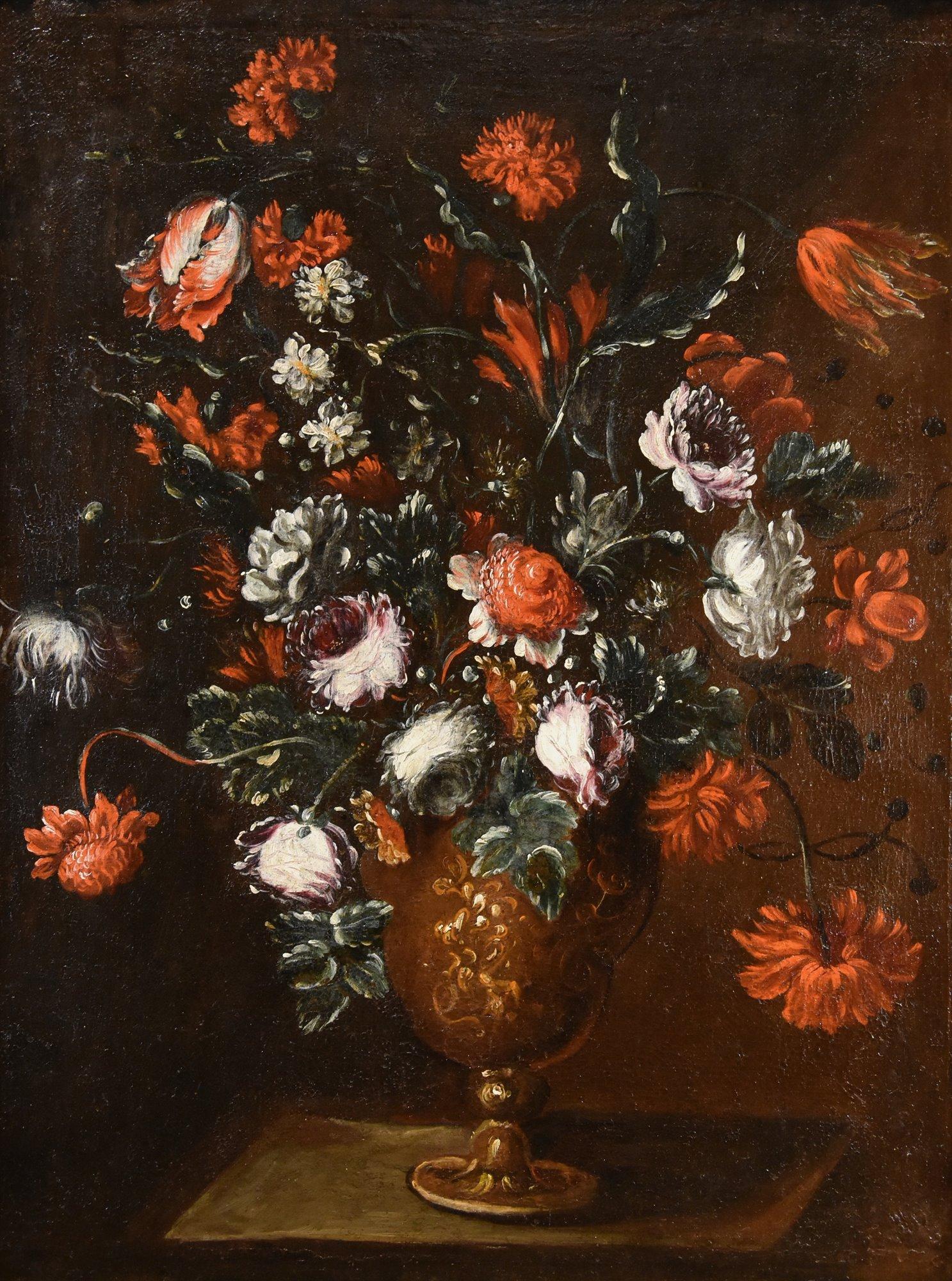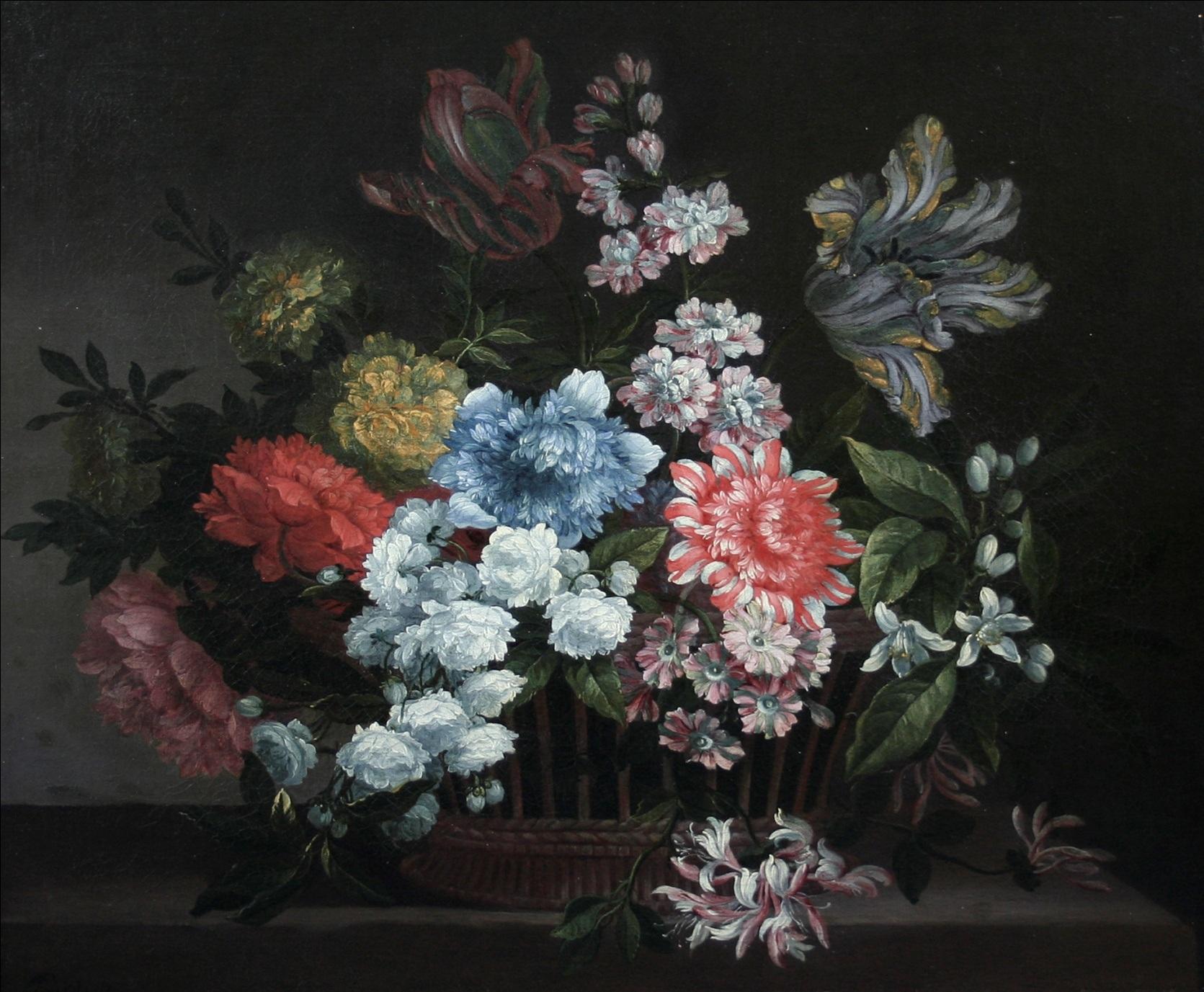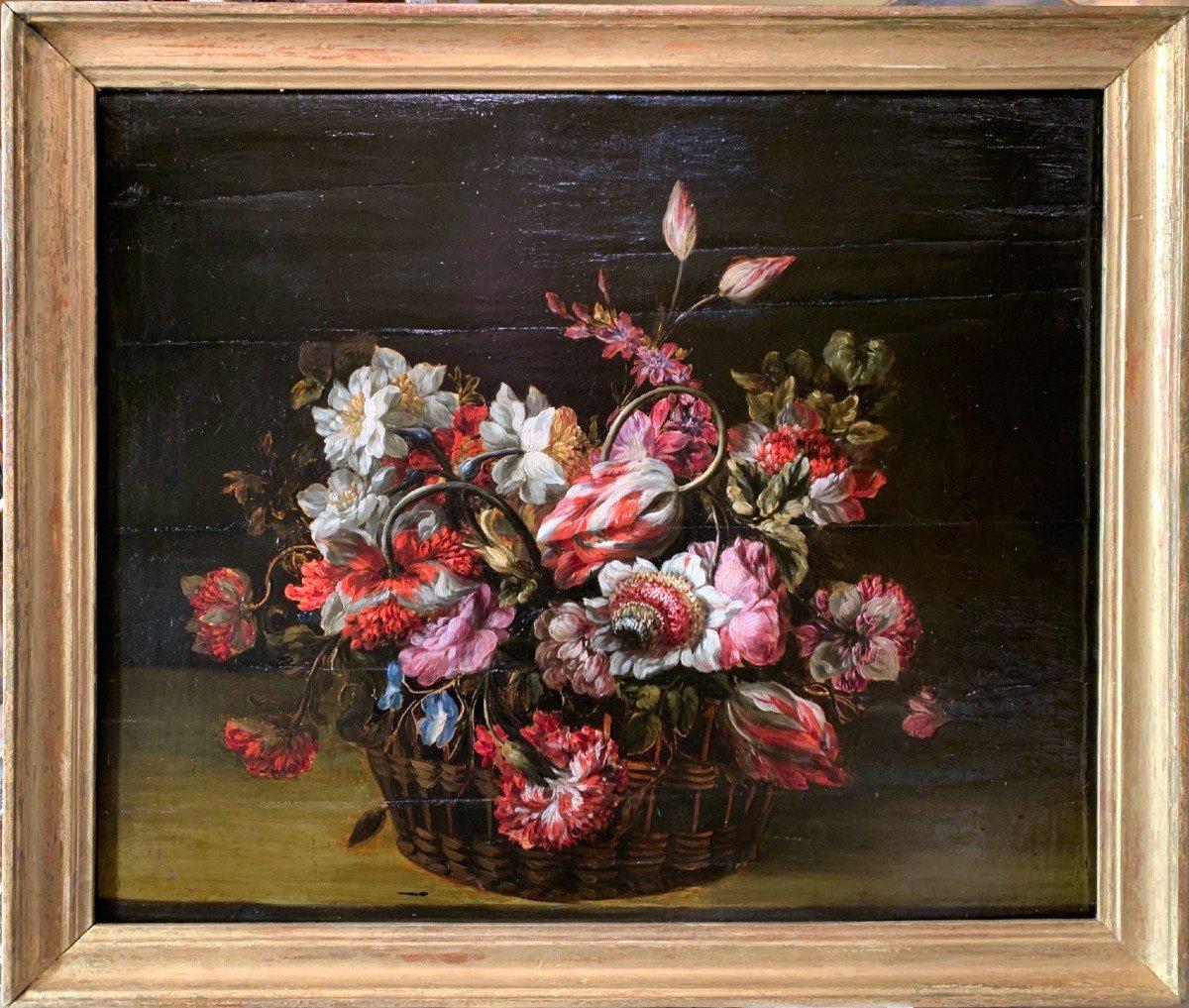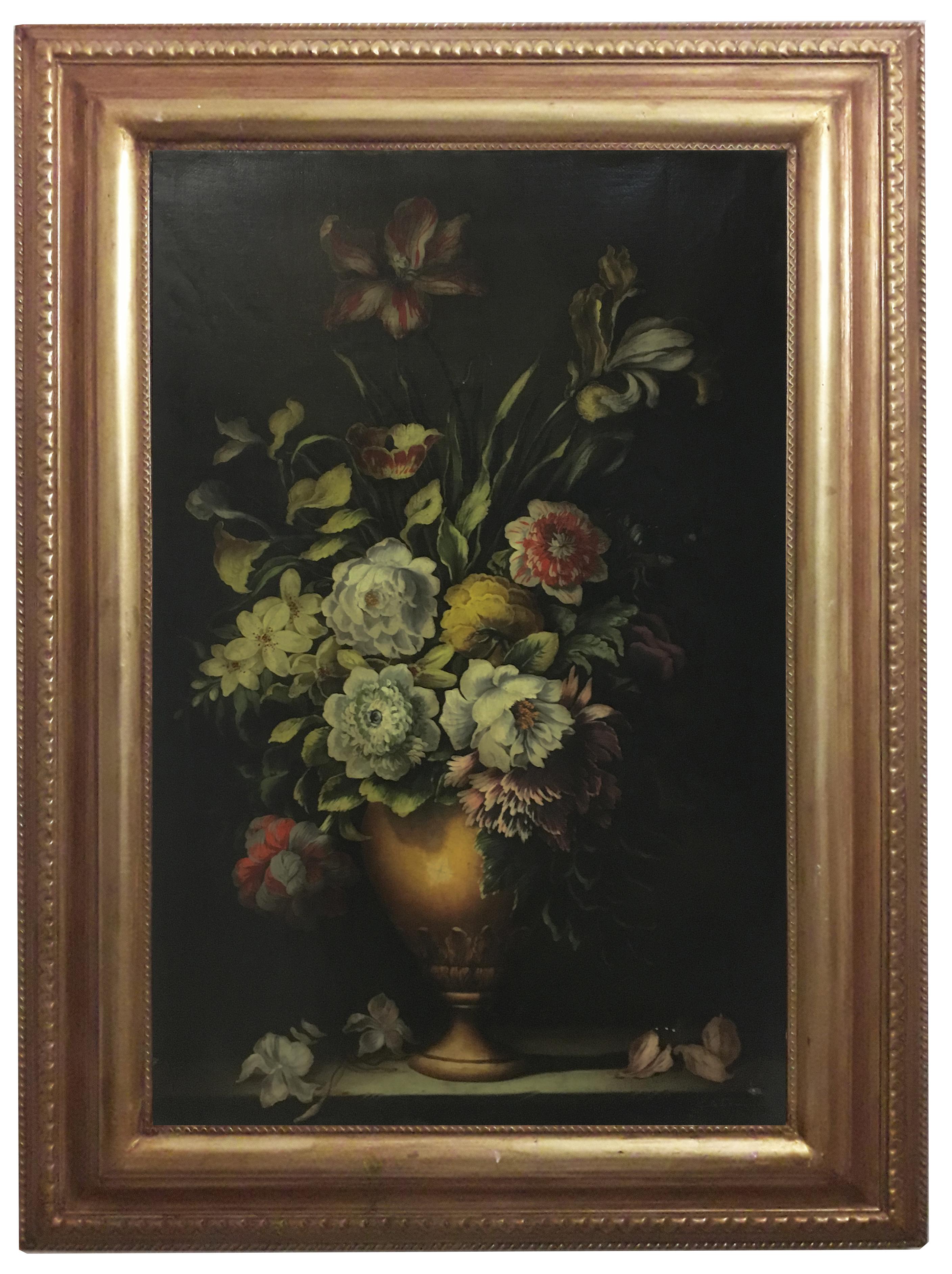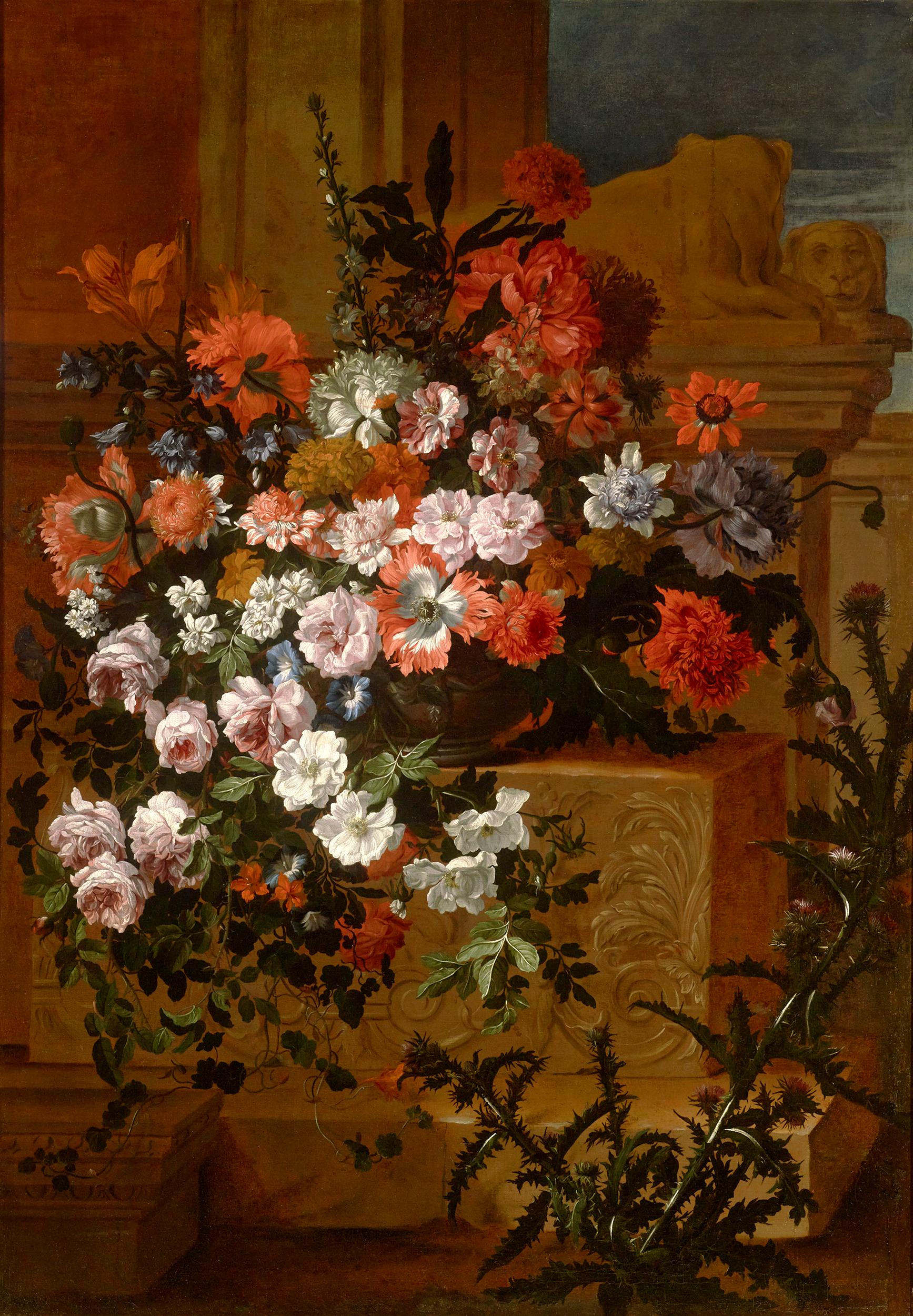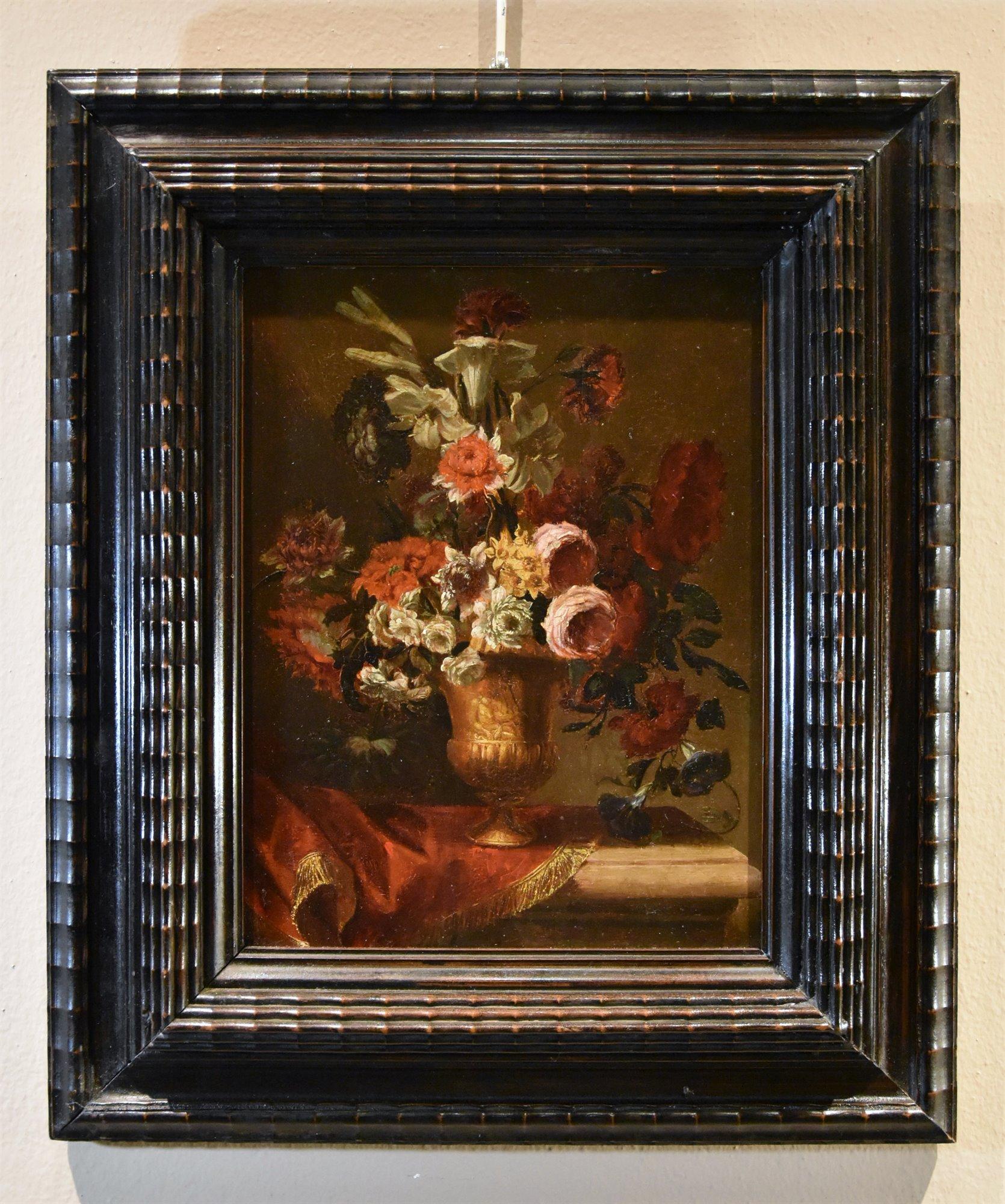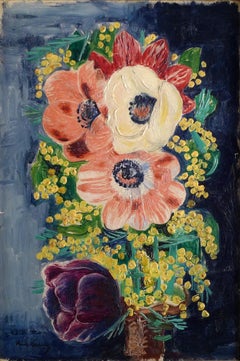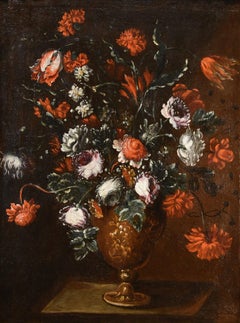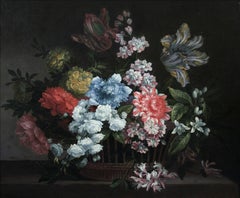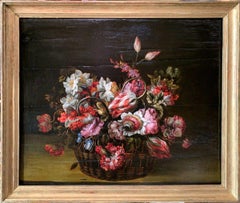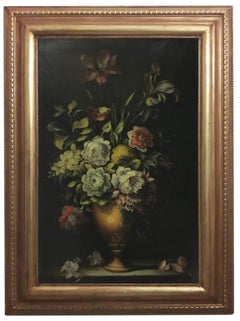Items Similar to "Cesta de flores", 17th Century Oil on Canvas, Still Flowers by Juan de Arellano
Want more images or videos?
Request additional images or videos from the seller
1 of 17
Juan de Arellano"Cesta de flores", 17th Century Oil on Canvas, Still Flowers by Juan de ArellanoCirca 1660
Circa 1660
$266,798.11
£200,509.72
€225,000
CA$373,637.41
A$409,765.34
CHF 212,229.62
MX$4,923,652.38
NOK 2,672,476.64
SEK 2,508,195.70
DKK 1,714,578.05
About the Item
JUAN DE ARELLANO
Spanish, 1614 - 1676
Cesta de Flores
signed Juan de Arellano (lower lright)
oil on canvas
original period carved, gilt and polychrome wood frame
22-1/2 X 27-5/8 inches (57 X 70 cm.)
framed: 31-1/4 X 36-3/8 (79 X 92 cm.)
PROVENANCE
CHRISTIE´S LONDON
Private Spanish Collection, Madrid
Spanish painter born in 1614 in Madrid (baptized August 3 in the parish of San Torcuato de Santorcaz) and died October 12, 1676 (was buried on 23 December San Felipe el Real). Already in the 17TH century it was one of the most famous Spanish painters, and owed its great artistic prestige and its economic well-being to his singular skill in the representation of baskets, vases and flower garlands. While already Juan Van der Hamen and Juan Fernández el Labrador had painted vases in the twenties and thirties of the 17TH century, is Juan de Arellano (and his artistic production, of which there are signed and dated from the 1940s examples) who should be considered the first (and the better and more effective) specialist in the painting of flowers in Spain.
The fact that Arellano maintained during more than 40 years one of the most important and popular bakeries public painting in Madrid, where he/she worked, apart from many currently unknown painters, also his son-in-law Bartolomé Pérez and his son José de Arellano, shows the fame and prestige of those who enjoyed Arellano already in life. It became the most sought-after painter of vases for commissions in the Spain of the 17TH century, and also worked for many churches of Madrid. Antonio Ponz mentions a few children, birds fruits and flowers painted on mirrors for the sacristy of San Jeronimo.
Scale optics Antonio Palomino(1724) and his unique artistic talent and his ability to work, but also of its mercantile spirit the Treaty the pictorial Museum bears witness. Palomino told Arellano that "applied to copy some vases of the Mario [Nuzzi]; After studying the natural flowers, he/she did them as above, none of the Spaniards exceeded him in the eminence of this ability; There are several testimonies in the temples and houses of Lords, and fans, and especially in the of the Lord count of Oñate, there are many, and great vases of Arellano; and there are four, which are upper thing, and not in the body of the chapel of our Lady of good counsel was less its study on fruits; and so great was its implementation, who painted both night and day [...]. Whither a day that had been given to the flowers; figures had left, and said: because this I work less and earn more; and thus was true; because it not only earned the pecuniary interests; but much more in the posthumous fame of his eminent ability."
He was the son of Juan de Arellano and Ana García, and father of the painters José Manuel, Manuel Jorge and Julián de Arellano. Although little is known of the first artistic formation of Arellano (Palomino relates that his mother gave him as an apprentice of an unknown painter in Alcalá de Henares) if there is evidence of that came in 1633, at the age of ten and nine years as an officer in the workshop of Juan de Solís in Madrid. In 1636 he/she declared to have received an amount of money by having performed with Ribiera Francisco a carriage for the Duke of Las Torres, and in 1639 he/she married María Banela in Madrid parish of Santa Cruz. In October 1643, he/she said having married María Corcuera, when his first wife died in May of this year. Among the at least eleven children born of this marriage between 1648 and 1669 should highlight to Juana (1648) was the wife of the painter of flowers Bartolomé Pérez, and the male José Manuel (1653), Manuel Jorge (1663) and Julian (1669) by having dedicated to painting.
Like many of the painters of the 17TH century, Juan de Arellano acted as assessor of collections of painting on several occasions and for a diverse clientele. It priced in 1644 the paintings that were upon the death of the count of Peñaflor; in 1646 the pictures of doctor Alonso of Elm and Valencia; in 1655 Francisco Doria pictures, innkeeper; in 1658 the inheritance left by the painter of still lifes Francisco barrier; In 1663 the pictures of Manuel Chamorro; in 1666 the pictures of Lorenzo Sánchez, merchant of books; in 1669 Alonso Romero of Alises; pictures in 1674 the paintings of Juan Antonio Fornelli, gentleman of the House of Castile; in 1675 the paintings that had been left by the death of Isabel Lozano.
His great public workshop would be host to a great number of disciples apprentices and officers, but while there is documentary confirmation that Francisco Hernández became an apprentice in his workshop in 1646, Lucas Santolus in 1648 and Miguel Herrán Jiménez in 1663, is not known yet if Bartolomé Pérez, who came to be his son-in-law and most faithful followerIt was his apprentice.
It was in the year 1650 when Juan de Arellano was moved to the main street, opposite San Felipe el Real, where he/she lived the rest of his life and where, among others, born José Manuel, the better, though still little known, of the painters sons of Juan de Arellano.
Although important recent research have been able to create a provisional Catalogue Raisonné, considered his works to hundreds of oil paintings, is difficult to establish a rigorous chronology between them, since many of the works (although mostly signed) have no date. The difficulties of attribution and dating will be resolved with the review and verification of the large number of tables that have been attributed to the artist lately and circulating on the market under his name, provided some signatures whose authenticity would be verified.
Although Palomino linking Arellano impulse to paint vases with the works of the Italian painter Mario Nuzzi, called Dei Fiori, his first work signed and dated (j. de Arellano Faciebat aetatis suae 32. 1646), wreath with the allegory of vanity (Valencia, private collection), carried out together with Francisco Camilo, who painted the children and the putto, shows the direct knowledge of Flemish painting, represented by the works of Daniel Seghers and Jan Brueghel. Two vases of bronze with birds and fruit, signed and dated (1647; Madrid, private collection) the following year, synthesize Flamenco elements, such as the disposition of the flowers and butterflies, with objects from the Italian art, such as the bronze vases taken from prints of ancient vessels recorded by Querubino Alberti on models of Polidoro of Caravaggio.
1652 date from signed two garlands of flowers with landscape (Madrid, Museo del Prado), prominent Flemish influence and almost insurmountable technical quality. Although other two pairs of garlands can be attributed him with certainty, there are no known signed works theirs until the year 1664, which are painted two (signed vases; Madrid, Naseiro collection), the pair of vases on capitals (signed; Particular, sold in Sotheby´s Amsterdam in 1984 collection) and another signed vase in a particular collection. 1665 are the basket of flowers (signed; Collection especially), the couple of dumps (signed vases; Private collection, sold in 1982 in Sotheby´s London) two (signed vases; Varez Fisa collection) and another signed basket of flowers (private collection). Dated in 1667 and signed are also the vase on vase glass (private collection) and a pair of vases (Madrid, Abello collection). From 1668 are the signed glass vase and Crystal (Madrid, Naseiro collection) (private collection), signed vase fruits and other signed vase in a particular collection of Madrid. Among his most spectacular and representative, works in what wealth of variety of flowers (in addition to butterflies, dragonflies and lizards) and pictorial technique is concerned, mention the two signed baskets with flowers from the Prado Museum and the basket of flowers of the Museo de Bellas Artes de Bilbao, signed and dated 1671.
The two versions known from the allegory of the sense of smell (one in the Masaveu collection, and the other in a private collection and also parts of a series of five paintings of the senses), San José and San Cristóbal (both with inscription of its name) of the parish of San Torcuato de Santorcaz, where was named after the artist, the Garland of flowers and fruits supported by putti (signed; Madrid, private collection), the Garland of flowers with bust of the Savior and the Garland of flowers with bust of the Virgin (both signed, Abello collection), and two versions of the Virgin nursing the child (one in Burgos, Cathedral, Chapel of Santa key, and the other in Toledo, Museum of Santa Cruz) can use as examples of its style in religious paintings, although it is still difficult to look at them with absolute certainty works only yours.
Among his paintings, priced the 20 October 1676 by Andrés de la Torre and Juan de Fontecha, after the death of Juan de Arellano on 13 October and before distributing them on 6 December of the same year between his three sons, were seventy-seven official portraits of court for official institutions, fourteen paintings of hunting dogsSeventeen paintings of hunting, fifteen representations of actual sites, eleven oil paintings of angels and Kings, four times and a large number of sacred paintings, mostly santos and santas. In addition were priced two sobreventanas of flowers with a few children (unfinished), a canvas with a vase of flowers, our Lady of milk with a Garland of flowers, ten paintings of different fruits, another wreath of flowers (unfinished), a vase of flowers, four trays of different flowers, another vase (unfinished) and two garlands. Thirteen books of prints, which surely had served as models also to their vases were also found among its assets at the time of his death.
Bibliography
AA.VV. Bank of Spain: collection of painting. Madrid, 1985.
AA.VV.Three centuries of painting, Caylus, 1995.
AGULLÓ and COBO, M. news on Madrid painters of the 16th - 18th. Granada, Universidad de Granada, 1978
-: More news on Madrid painters of the 16th to 18th centuries. Madrid, 1981.
-: Documents for the history of Spanish painting, I. Madrid, 1994.
AGULLÓ and COBO, M. and BARATECH, M. T. documents for the history of Spanish painting, II. Madrid, 1996.
ANGULO ÍÑIGUEZ, D. Pintura from the 17TH century (Ars Hispaniae, Vol. XV). Madrid, 1971.
ANTONIO, T. and ORIHUELA, M. (Commissioners). The beauty of the real (exhibition catalogue...). Madrid, Museo del Prado, 1995.
NEIGHBORHOOD MOYA, j. L. "The House of the painter Juan de Arellano" in Spanish archive of art, 1984, pp. 325-326.
BAYON, D. "Originality and significance of the first Spanish still lifes" in Revista de Ideas Estéticas, 1970.
Bergstrom, i. Spanish master of still life and vases from the 17TH century. Madrid, 1970.
-: "Flower pieces of Radial Composition in European 16th and 17th Century Art" in Album Amicorum J. G. van Gelder. The Hague, 1973.
Bergstrom, i. et to the. Natura in poses. Milan, 1977.
CALVO SERRALLER, f. (editor). Theory of the painting of the golden age. Madrid, 1991.
-: (Commissioner). The Spanish Bodegón de Zurbarán to Picasso (exhibition catalogue). Bilbao, Museum of fine arts, 1999.
-: (Commissioner). Spanish flowers in the golden century (exhibition catalog). Madrid, Museo del Prado, 2002 / 2003.
CAVESTANY, j. (Commissioner). Vases and still lifes in Spanish painting (exhibition catalogue). Madrid, Palacio of the national library, 1936-1940.
CEÁN BERMÚDEZ, J. A. Diccionario historical of the more illustrious teachers of the beautiful arts, 6 vols. Madrid, 1800.
CHERRY, p. "New documents on Bartolomé Pérez" at Apollo, March, 1995, pp. 43-48.
-: Art and nature. The Spanish still life in the golden age. Madrid, the history of Hispanic Art Foundation, 1999.
DAVILA, f. "in the parish of San Torcuato de Santorcaz (Madrid). Two unknown pictures of Juan de Arellano"in Gallery antiquarian, 88, 1991.
Duke OLIART, M. "flower painting. The work of Juan de Arellano"in Goya, 191, 1986, pp. 272-279.
JORDAN, w. B. (Commissioner). Spanish Still life in the Golden Age: 1600-1650 (exhibition catalogue). Fort Worth, Kimbell Art Museum, 1985.
JORDAN, w. B. & CHERRY, p. (Commissioners). Spanish Still life painting from Velazquez to Goya (exhibition catalogue). London, National Gallery, 1995.
JORDAN, w. B. (Commissioner). An Eye on Nature (exhibition catalogue). London, Matthiesen Gallery, 1997.
Martin, I. Juan de Arellano and the Flowers Painting in Madrid (doctoral thesis). Dallas, Southern Methodist University, 1980.
PALOMINO DE CASTRO y VELASCO, to. The pictorial Museum and optical scale (2 vols., Madrid, 1715 and 1724). Madrid, 1947.
-: Pictorial Museum and optical scale (2 vols., Madrid, 1715 and 1724), 3 vols. Madrid, 1988.
PÉREZ SÁNCHEZ, A. E. (Commissioner). Spanish painting of still life and vases from 1600 to Goya (exhibition catalogue). Madrid, Museo del Prado, 1983.
PÉREZ SÁNCHEZ, A. E. The nature morte espagnole du XVIIe siècle à Goya. Paris, 1987.
-: (Commissioner). Juan de Arellano, 1614-1676 (exhibition catalogue). Madrid, Fundación Caja Madrid, 1998.
PONZ, A. (18 vols., Madrid, 1772-94) Spain trip. Madrid, 1972.
SCHEFFLER, f. Das spanische Stilleben des 17.Jahrhunderts: Theorie, Genese und Entfaltung einer neuen Bildgattung. Frankfurt am Main, Vervuert Verlag, 2000
SORIA, M. S. and KUBLER, G. Art and Architecture in Spain and Portugal and their American Dominions 1500-1800 (The Pelikan History of Art), 1959.
TORMO, E. Alcala de Henares. Madrid, National Board of tourism, n.d. (h. 1930).
VALDIVIESO, e. "An unpublished vase signed by Juan de Arellano" in Spanish archive of art, 1973, pp. 191-192.
VALDIVIESO, e. "Palacio Real de Aranjuez. Vases and still life II, Dutch, Italian and Spanish schools"in real sites, 52, 1977.
VALDIVIESO, e. "A Vanitas of Arellano and Camilo" in Bulletin of the seminar of study of art and archaeology, Valladolid, 1979, pp. 479-482.
YOUNG, E. Four Centuries of Spanish Painting. Barnard Castle, The Bowes Museum, 1967
-: "New Perspectives in Spanish Still Life Painting in the Golden Age" in The Burlington Magazine, April, 1976, p. 213.
Felix Scheffler
"
- Creator:Juan de Arellano (1614 - 1676)
- Creation Year:Circa 1660
- Dimensions:Height: 22.45 in (57 cm)Width: 27.56 in (70 cm)
- More Editions & Sizes:57 x 70 cm.Price: $266,798
- Medium:
- Movement & Style:
- Period:
- Condition:
- Gallery Location:Madrid, ES
- Reference Number:1stDibs: LU128114769532
About the Seller
5.0
Vetted Professional Seller
Every seller passes strict standards for authenticity and reliability
Established in 1977
1stDibs seller since 2019
21 sales on 1stDibs
Typical response time: 3 hours
- ShippingRetrieving quote...Shipping from: Madrid, Spain
- Return Policy
Authenticity Guarantee
In the unlikely event there’s an issue with an item’s authenticity, contact us within 1 year for a full refund. DetailsMoney-Back Guarantee
If your item is not as described, is damaged in transit, or does not arrive, contact us within 7 days for a full refund. Details24-Hour Cancellation
You have a 24-hour grace period in which to reconsider your purchase, with no questions asked.Vetted Professional Sellers
Our world-class sellers must adhere to strict standards for service and quality, maintaining the integrity of our listings.Price-Match Guarantee
If you find that a seller listed the same item for a lower price elsewhere, we’ll match it.Trusted Global Delivery
Our best-in-class carrier network provides specialized shipping options worldwide, including custom delivery.More From This Seller
View All"Still Life with Fruits", 17th Century Oil on Canvas by Flemish School
Located in Madrid, ES
FLEMISH SCHOOL
17th Century
STILL LIFE WITH FRUITS
unsigned
oil on canvas
17-3/4 x 21-3/4 inches (45 x 55 cm.)
framed: 22 x 27 inches (56 x 68 cm.)
PR...
Category
17th Century Flemish School Still-life Paintings
Materials
Canvas, Oil
Spanish 18th C. Oil on Canvas"Still Life with Walnuts, Melon, Grapes and Orange"
Located in Madrid, ES
SPANISH SCHOOL
18th CENTURY
STILL LIFE WITH WALNUTS, MELON, GRAPES AND ORANGE
unsigned
oil on canvas
15-3/4 x 21 inches (40 x 53 cm.)
framed: 24-1/2 x 28-3/4 inches (62 x 72.5 cm.)
...
Category
18th Century Baroque Still-life Paintings
Materials
Canvas, Oil
"Still Life with Fruits", Large, Early 20th Century Oil on Canvas by Celso Lagar
By Celso Lagar
Located in Madrid, ES
CELSO LAGAR
Spanish, 1891 - 1966
STILL LIFE OF FRUITS
signed "Lagar" lower left
oil on canvas
29-3/4 x 38 inches (75 x 96 cm.)
framed: 33-1/2 x 41-3/4 inches (84.5 x 105.5 cm.)
PROVENANCE
Private French Collector
Celso Lagar Arroyo (Ciudad Rodrigo, 1891 - Seville, 1966) was an expressionist Spanish painter of the first generation of the School of Paris, where he lived most of his life. He was influenced by avant-gardes of all kinds, such as cubism and fovism. He painted mainly landscapes and still lifes...
Category
Early 20th Century Expressionist Still-life Paintings
Materials
Canvas, Oil
"Bouquet of flowers with mimosas", 20th Century Oil on Canvas by Moïse Kisling
Located in Madrid, ES
MOÏSE KISLING
French-Polish, 1891 - 1953
BOUQUET OF FLOWERS WITH MIMOSA
signed & dedicated "à Edith Mara", Kisling (lower left)
oil on canvas
13 X 88-1/2 inches (33 X 22.5 cm.)
frame...
Category
1930s Expressionist Still-life Paintings
Materials
Canvas, Oil
"Still Life" 20th Century Oil on Canvas by Spanish Artist Antoni Clavé
By Antoni Clavé
Located in Madrid, ES
ANTONI CLAVÉ
Spanish, 1913 - 2005
STILL LIFE
signed "Clavé" lower right
also inscribed "Ce tableau a ete peint par moi vers 1946, Clavé" on the reverse
oil on ...
Category
1940s Abstract Still-life Paintings
Materials
Canvas, Oil, Cardboard
"Interieur aux Fleurs Jaunes" 20th Century Oil on Canvas by Emilio Grau Sala
By Emilio Grau Sala
Located in Madrid, ES
EMILIO GRAU SALA
Spanish, 1911 - 1975
INTERIEUR AUX FLEURS JAUNES
signed "Grau Sala" (lower left)
signed again, located, dated and titled "Grau Sala, Paris 61, Interieur aux fleurs jaunes" (on the reverse)
oil on canvas
15 x 18-1/4 inches (38 x 46 cm.)
framed: 23-1/2 x 26-1/2 (59.5 x 67 cm.)
PROVENANCE
Private Parisian Collection
Interieur aux fleurs jaunes
This interior with two female figures where also the plans made in different colors are drawing the composition.
The abundant pictorial material distributed in geometric portions, gives life to the tablecloth and mother and daughter figures, in black and white colors of the jacket, while the black line takes care of the environments so as not to separate them.
The fruit bowl and flowers give a cheerful touch with their pastel tones.
Emilio Grau Sala came from a family of artists. He was born in Barcelona in 1911 and his father, a good cartoonist, had been one of the promoters of the "Salon des Humanistes" and made his exhibitions normally in "Sala Parés", Barcelona.
His first works were exhibited at the Salon des Independents. In the years 1930-33 he had painted under the influence of Cubism, especially that of Torres García. It is from that time a painting of the port of Barcelona, geometric and structural, which completely anticipated what would later be his work. His personality began fully painting watercolors and oils with a certain fantasy character, with a point of decorative instinct and themes full of naivety and grace. Romantic interiors, paddocks, port scenes, sailors, etc.
Grau Sala was essentially a Mediterranean painter, son of post-impressionism and enriched with French painting of the last fifty years. Mediterranean because his work has the color and light of that land.
He understood and assimilated impressionist painting very well, and for that reason he was never subject to the modules of a formulist realism, nor the sexigencias of the forms.
In Paris he found the best environment to give us a fruitful and intense work, because he could use the expressive potential of French art to enrich it.
All this made him a very esteemed artist everywhere where his work was known. He was also very often required to illustrate books and publications in Paris. Also his posters were very successful.
He painted a large number of subjects, but perhaps the theme of horse racing is where you can see in a very clear way the joyful and optimistic life that was lived at that time. In this fabric there is an explosion of juicy and vivid colors full of ingenuity and simplicity in its composition. Only a teacher could turn the complicated into something simple and beautiful. Before this work we feel a deep emotion, the emotion of before starting a horse race. Joy and nervousness at the same time. Especially since it is a direct emotion. There are no intermediaries between our eyes and what the work intends to tell us. This is precisely what seduces and catches us of this painting.
His works can be found in the Museums of the Villa de Paris, L'Ile de France Museum, at the Château de Sceaux, Honfleur Museum, La Rochelle Museum, Barcelona Museum...
Category
1960s Fauvist Interior Paintings
Materials
Canvas, Oil
You May Also Like
Flowers Still-life Volo 17th Century Paint Oil on canvas Old master Italt
Located in Riva del Garda, IT
Francesca Volò Smiller, called Vincenzina (Milan, 1657 - 1700) attributed
Floral composition overflowing from an embossed vase
(LINK)
Oil on canvas
79 x 61 cm.
Framed 89 x 70 cm.
T...
Category
17th Century Old Masters Paintings
Materials
Oil
$8,964 Sale Price
20% Off
Flowers In A Basket - Original Oil, Still Life, French, Franco-Flemish painter
By Jean-Baptiste Monnoyer
Located in Knowle Lane, Cranleigh
Flowers in A Basket by Jean-Baptiste Monnoyer. A Still Life of flowers in a basket including jasmine, honeysuckle, dahlias, parrot tulips, delphiniums and white carnations.
Category
1690s Baroque Still-life Paintings
Materials
Oil, Canvas
Bouquet De Fleurs (entourage) De Margherita Caffi (1648 - 1710)
Located in GOUVIEUX, FR
Huile sur panneau de pin Dim sans cadre 60/52 Dim avec cadre 68/59 Ecole italienne Entourage de Margherita Caffi Margherita Caffi (Milan, 1648 - Milan, 20 septembre 1710), est une ...
Category
Mid-17th Century Still-life Paintings
Materials
Oil
FLOWERS - Dutch School -Italian Still Life Oil on Canvas Painting
By Carlo De Tommasi
Located in Napoli, IT
Flowers - Carlo De Tommasi Italia 2008 - Oil on canvas cm. 90x60
In this painting Carlo De Tommasi is inspired by the eighteenth-century works of Abrham Bosschaert Dutch painter, kno...
Category
Early 2000s Dutch School Still-life Paintings
Materials
Canvas, Oil
Still Life With Flowers By Jean-Baptiste Monnoyer
By Jean-Baptiste Monnoyer
Located in New Orleans, LA
Jean-Baptiste Monnoyer
1636-1699 French
Still Life with Flowers on a Carved Stone Ledge
Oil on canvas
Impeccable detail and luminous color breathe life into this floral still lif...
Category
17th Century Old Masters Still-life Paintings
Materials
Canvas, Oil
Price Upon Request
Still-Life Flowers 17th century Flemish School Paint Oil on table Old master
Located in Riva del Garda, IT
17th-century Flemish school
Still life with flowers
Oil on panel 33 x 25 cm In frame 50 x 42 cm
The painting depicts a wonderful still life of flowers, where numerous colour...
Category
17th Century Old Masters Paintings
Materials
Oil
$4,316 Sale Price
20% Off
More Ways To Browse
Religious Oil Painting 17th Century
Bird On Flower
Oil On Board 18th Century
Flemish 18th Century Oil Painting
Portrait Of A Lady Spain
Carved Wood Mirror With Birds
Pair Of Still Life Fruit
18th Century Italian Religious Paintings
Signed Vases Crystal
Bronze Fruit
Antique Angel Paintings
Large Crystal And Bronze Vase
Antique Mercantile
Vase With Fruit
Bird Oil Painting 18th Century
Antique Bakery
Picasso Mother And Child Print
Bronze Vase And Bird
